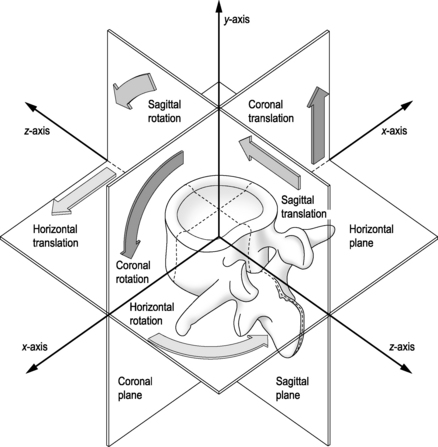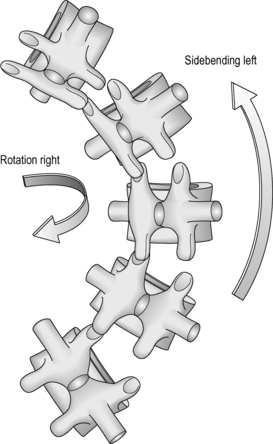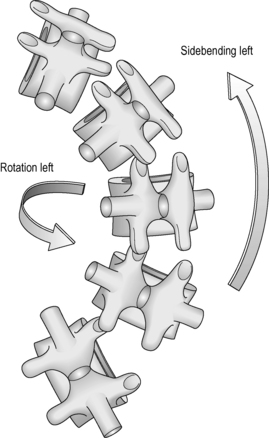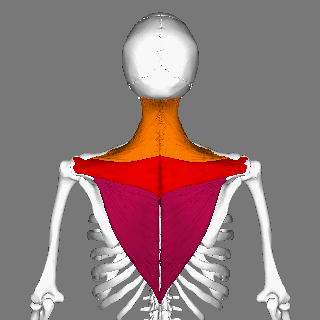Showing posts with label 解剖學. Show all posts
Showing posts with label 解剖學. Show all posts
Thursday, October 18, 2018
Wednesday, August 29, 2018
[進階肌動學] 肩胛舌骨肌症候群
肩胛舌骨肌是一條非常有趣
但卻常常被忽略的肌肉
這是唯一一條兩側都接到沒有與身體有真關節連結的骨頭上
分別是我們的舌骨以及肩胛
所以這條肌肉可說一條漂浮的肌肉
肩胛舌骨肌是下舌骨肌群最外側的肌肉
包含上腹(Superior Belly)、下腹(Inferior Belly)、與中央肌腱(Intermediate Tendon)
而中央肌腱正好落在胸鎖乳突肌的正下方,可以作為一個觸診上的分界
 |
| By Olek Remesz (wiki-pl: Orem, commons: Orem) Own work, based on this picture from Gray's Anatomy., CC BY-SA 2.5, Link |
這條肌肉由頸神經叢的頸環(Ansa cervicalis)C1-C3所支配
上根(Superior Root)來自於C1,下根(Inferior Root)則來自於C2-C3
分別支配了肩胛舌骨肌的上腹與下腹
 |
| By Juliustang (talk) (Uploads) - Own work, Public Domain, Link |
1. 喉嚨異物感
2. 吞嚥困難/疼痛
3. 頸部肌肉膨大
4. 肩胛失能
其中最能直接判別的是在吞嚥時會產生X型的肌肉突起
 |
| 左側為放鬆狀態,右側為吞嚥時 |
有一派理論認為是因為深層頸椎筋膜失能
導致無法穩定中央肌腱
所以在吞嚥動作時產生向上浮起的動作
呈現出我們看到的X型肌肉
 |
| B為正常吞嚥動作,C為OMS的吞嚥動作 |
通常需要將肩胛舌骨肌放鬆
然後重新訓練舌骨肌群在吞嚥下的動作
避免過多的張力累積在這個區域
Reference:
1. Wong, D. S., & Li, J. H. (2000). The omohyoid sling syndrome. American journal of otolaryngology, 21(5), 318-322.
2. Lee, A. D., Yu, A., Young, S. B., Battaglia, P. J., & Ho, C. J. (2015). Omohyoid muscle syndrome in a mixed martial arts athlete: a case report. Sports health, 7(5), 458-462.
3. Kim, L., Kwon, H., & Pyun, S. B. (2009). Pseudodysphagia due to omohyoid muscle syndrome. Dysphagia, 24(3), 357-361.
本著作由I-Chen Liu, PT, MS, DPT, OCS製作,以創用CC 姓名標示-非商業性-相同方式分享 4.0 國際 授權條款釋出。
Monday, June 18, 2018
[運動討論] 足球選手的傷害預防(1) Football Injury Prevention(1)
四年一次的世界盃足球賽又開始啦
資深老球迷與一日球迷都準備好出動了嗎
Here comes FIFA 2018
Be prepared, all old and bandwagon fans.
Here comes FIFA 2018
Be prepared, all old and bandwagon fans.
世足賽期間當然要應景寫足球相關的文章
首發的內容當然要遵照我們的重要概念之一 - 預防勝過治療
所以我們要來介紹一個非常有效的足球員傷害預防計畫 FIFA11+
During this festival period, I definitely need to write something about it.
The very first article must accommodate one of our core value - "Prehab than Rehab"
So here I'd like to introduce a very effective football injury prevention program, FIFA 11+
FIFA 11+是由跨國際專家團隊
在使用各式傷害預防計畫後
藉由他們的實際經驗整合而成
最原始是設計於14歲以上的業餘足球選手
後來也發展出了FIFA 11+ for kid以及
FIFA 11+ is developed by an international group of experts
based on their experience with different prevention program.
It is first implemented to amateur football player above 14 years old.
The program for kid is also developed lately.
根據Barengo et all, 2014的系統性回顧
在普遍的情況下執行此計畫後可以降低隊伍30-70%的受傷數
另外在每週至少執行1.5次計畫的高配合選手身上
針對所有傷害的機率可以降低35%
According to a systemic review by Barengo et all, 2014
In general, the team which applied this program has the decreased injury number from 30-70%
For the high compliance player who performed the program at least 1.5 time/week,all injuries risk can be reduced by 35%
FIFA 11+總共分成三個部分, 十五個動作
第一部份是低速的跑步配合主動伸展
第二部分是六組針對核心, 腿部力量, 平衡, 敏捷的訓練
第三部分是中高速的跑步配合急停與切入
There are 15 movements, 3 parts
Part one is running exercise at low speed with active stretch
Part two is a set of six exercises that focus on core, leg strength, balance, and agility.
Part three is running exercise at mod/high speed with plan and cut
未來幾篇文章
我們會深入探討三個部分的動作
配合動作力學上的分析
來看看這些動作的目的以及為什麼會有效
In the future post,
I'll dig deeper into those movements.
With movement analysis,
let's figure out what those movements aim to and why they are effective.
Enjoy you FIFA 2018!
本著作由I-Chen Liu, PT, MS, DPT, OCS製作,以創用CC 姓名標示-非商業性-相同方式分享 4.0 國際 授權條款釋出。
Tuesday, June 5, 2018
[進階肌動學] 多裂肌的深層分析 Deeper into Multifidus
多裂肌是人體背側重要的核心肌群
由薦骨開始一路向上到頸椎
每一個單位向上2-4節脊椎連結到棘突上
是重要的脊椎穩定肌群
Multifidus is the important core muscle on the back
From sacrum all the way up to neck
Every unit goes 2-4 segment above toward the spinous process.
Play an important role as a lumbar stablizer
由薦骨開始一路向上到頸椎
每一個單位向上2-4節脊椎連結到棘突上
是重要的脊椎穩定肌群
Multifidus is the important core muscle on the back
From sacrum all the way up to neck
Every unit goes 2-4 segment above toward the spinous process.
Play an important role as a lumbar stablizer

由於多裂肌本身的組織排列
在身體向前彎曲時多裂肌可以產生最大的肌力
這也間接證實了多裂肌在矢狀面上身為穩定肌群的能力
Due the the sacromere length change,
Multifidus generates max strength output during trunk flexion.
That somehow implies the ability as a trunk stabilizer on saggital plane.
許多的研究顯示在慢性下背痛的患者身上
會發現多裂肌失能的狀況
也會在影像學上觀察到
明顯腰部多裂肌受到脂肪組織取代萎縮的現象
Many researches showed that multifidus dysfunction occur among chronic low back pain population.
Also form image studies,
the fat will infiltrate multifidus tissue, A.K.A multifidus atrophy.
因此如何正確的評估與誘發多裂肌的活動
對於下背痛的患者來說非常重要
Thus, its important to assess and activate multifidus for low back pain population.
臨床上有兩個適合評估多裂肌的動作
多裂肌抬高測試(MLT)以及後彎測試
There are two excellent movements can be used to assess multifidus.
Multifidus Lifting Test (MLT) and multi-segmental extension test
多裂肌抬高測試是在四足跪姿下進行
受試者需先維持脊椎中立
然後將腳或手抬起
如果腰椎無法維持姿勢就是陽性
MLT is performed under quadruped position
The subject need to get the neutral spine first,
then raising arm or leg or both.
Belly dropping or can not maintain neutral spine are consider positive
後彎動作是另一個非常簡單可以快速執行的理學測試
主要評估要點有兩個
1. 腰椎是否過度前凸
2. 脊椎是否有折點出現
這兩個現象都表示多裂肌的失能導致無法有效的分散後彎壓力
Multi-segmental extension is another easy PE.
There are two signs we need to watch out
1. Hyperlordorsis of the lumbar
2. Any hinge point on the spine
Both signs tell you that multifidus is dysfuntion that cannot distribute the pressure properly.
當我們處理完結構上或肌肉控制的問題之後
我們必須要指導個案如何正確使用多裂肌
下面介紹兩個我常用的多裂肌啟動與訓練的方式
After dealing with the structural issue and motor control issue,
we need to teach them how to use their multifidus.
Below are two exercises I use a lot to activate multifidus.
改良多裂肌超人式
傳統超人式在執行上容易過度使用脖子與豎脊肌群
反而可能造成更多的症狀產生
而在將手腳抬起前
先讓上肢往身體收進來
可以徵召核心穩定肋骨
Mofified Superman by Dr. Kathy Dooley
Original superman may over recruit neck and erector spinae during practice,
which might make the symptom worse.
Instead, you can add a pulling movement of the arms before raising limbs.
That can help you recruit core muscles to stabilize ribs during movement.
側躺多裂肌啟動
想像你的胯下與背後有一條線連接在一起
將這條線縮短並把腰椎向上略為抬高
從屁股的位置給予一個輕輕向前推的力量
另一隻手可以去感受多裂肌是否收縮或式產生過度豎脊肌活化
Sidelying Mf activation
Think about there's a ling connecting your groin and lumbar spine
Contracting this line gently and lifting lumbar vertebra up slightly
Then you can give light resistance to push pelvis forward
Another hand can touch their back to feel if the Mf is contracting or erector is over activating.
多裂肌是背後的核心
協助我們抵抗重力與旋轉
下背的穩定除了腹肌核心以外
多裂肌的訓練是一個不可忽略的重要因素
Multifidus is core of the back.
It assists us against gravity and rotation.
In order to stabilize low back spine,
multifidus is one muscle you can not neglect.
參考文獻
1. Freeman, M. D., Woodham, M. A., & Woodham, A. W. (2010). The role of the lumbar multifidus in chronic low back pain: a review. PM&R, 2(2), 142-146.
2.Ward, S. R., Kim, C. W., Eng, C. M., Gottschalk IV, L. J., Tomiya, A., Garfin, S. R., & Lieber, R. L. (2009). Architectural analysis and intraoperative measurements demonstrate the unique design of the multifidus muscle for lumbar spine stability. The Journal of Bone and Joint Surgery. American volume., 91(1), 176.
3. Fortin, M., & Macedo, L. G. (2013). Multifidus and paraspinal muscle group cross-sectional areas of patients with low back pain and control patients: a systematic review with a focus on blinding. Physical therapy, 93(7), 873-888.
4. Kjaer, P., Bendix, T., Sorensen, J. S., Korsholm, L., & Leboeuf-Yde, C. (2007). Are MRI-defined fat infiltrations in the multifidus muscles associated with low back pain?. BMC medicine, 5(1), 2.
本著作由I-Chen Liu, PT, MS, DPT, OCS製作,以創用CC 姓名標示-非商業性-相同方式分享 4.0 國際 授權條款釋出。
Friday, May 11, 2018
[基礎伸展] 上斜方肌 Upper trapezius stretch
與提肩胛肌關係密切
負責的動作有頸椎後仰, 同側側彎, 對側旋轉
而在肩膀的位置則負責肩胛骨的上提與上轉
Upper trapezius is another important muscle of neck-shoulder areaIt has the close relationship with levator scapulae
The movement at the cervical are extension, same side side-bending, opposite side rotation
And the movement at the shoulder are elevation and upward rotation
上斜方肌過度緊繃的時候
常見的情況有1. 頭部旋轉, 側彎活動受限
2. 肩關節活動障礙
3. 在枕骨下外側, 頸肩連線中點 或後3/1鎖骨處產生酸痛點
Some common conditions while upper trapezius is tight:
1. Neck side-bending and rotation limitation
2. Shoulder dysfunction
3. Tender points over the lateral suboccipital area, mid-point of the shoulder, or 1/3 of the clavicle
靜態伸展上斜方肌的動作是
1. 頭部向對側側彎加上同側旋轉
2. 對側手拉住頭部
3. 同側手向下固定
The static stretch includes the following movement:
1. Neck side bends to opposite side and turns to the same side.
2. Opposite hand holds the neck
3. Same side arm anchor at the bottom
Below is the standard static stretch of upper trapezius.
 |
| https://learnmuscles.com/glossary/upper-trapezius-stretching/ |
一樣由我示範如何執行動態伸展
頭部的姿勢維持不變
讓同一側的肩胛上抬, 再下壓
利用肩胛骨上下的動作進行上斜方肌的伸展
Let me show you how to perform dynamic stretch to this muscle
The head and opposite hand position remain.
The same side shoulder elevates up and down,
using scapula elevation/depression to stretch this muscle.
斜方肌也是辦公室一族非常容易不舒服的位置
藉由簡單的左右旋轉就可以分辨到底是斜方肌還是提肩胛肌的緊繃
Upper trapezius is also the common tight muscle among office population
By simply rotating your head to both sides, you can differentiate which muscle is truly tight.
本著作由I-Chen Liu, PT, MS, DPT, OCS製作,以創用CC 姓名標示-非商業性-相同方式分享 4.0 國際 授權條款釋出。
Tuesday, May 1, 2018
[基礎伸展] 提肩胛肌 Levator scpulae stretch
 |
| By modified by Uwe Gille - Gray Image:Gray409.png, Public Domain, Link |
由頸椎第一至第四橫突, 向下連接到肩胛上角
負責的動作有頸椎後仰, 同側側彎, 同側旋轉
而在肩膀的位置則負責肩胛骨的上提與下轉
Levator scapulae are the muscles that connect cervical and scapula
From C1-C4 transverse process to superior angle of scapula
The movement at the cervical are extension, same side side-bending, same side rotation
And the movement at the shoulder are elevation and downward rotation
Levator scapulae are the muscles that connect cervical and scapula
From C1-C4 transverse process to superior angle of scapula
The movement at the cervical are extension, same side side-bending, same side rotation
And the movement at the shoulder are elevation and downward rotation
提肩胛肌過度緊繃的時候
常見的情況有
1. 頭部旋轉, 側彎活動受限
2. 肩關節活動障礙
3. 在頸部或是肩胛上緣產生酸痛點
Some common conditions while levator scapulae are:
1. Neck side-bending and rotation limitation
2. Shoulder dysfunction
3. Tender point over the lateral neck or superior angle of scapula
靜態伸展提肩胛肌的動作是
1. 頭部向對側旋轉約45度然後往下看
2. 對側手拉住頭部
3. 同側手舉高並貼住頸椎
而伸展這條肌肉的標準模範
由勝文替你示範
The static stretch includes the following movement:
1. Neck rotates to opposite side about 45 degrees and bends down.
2. Opposite hand holds the neck
3. Same side arm raises up and holds the neck
Below is the standard static stretch of levator scapulae.
動態伸展是另一個很不錯的方式
有些時候甚至比起靜態伸展更能維持舒緩的效果
頭部的姿勢維持不變
同一側的手往上舉高, 再移動回來
利用肩胛骨旋轉的動作進行提肩胛肌的伸展
Dynamic is another good way to stretch levator scapulae.
Sometimes it's more effective than the static stretch.
The head and opposite hand position remain.
The same side arm raise all the way up and back down,
using scapula rotation to stretch this muscle.
提肩胛肌是辦公室一族非常容易緊繃的一條肌肉
使用電腦之餘記得做運動
可以大幅降低肩頸僵硬與痠痛的機會
Levator scapula is getting tight easily among office population.
Remember to do some exercise while using the computer.
That can help you decrease the chance of neck stiffness and pain.
常見的情況有
1. 頭部旋轉, 側彎活動受限
2. 肩關節活動障礙
3. 在頸部或是肩胛上緣產生酸痛點
Some common conditions while levator scapulae are:
1. Neck side-bending and rotation limitation
2. Shoulder dysfunction
3. Tender point over the lateral neck or superior angle of scapula
靜態伸展提肩胛肌的動作是
1. 頭部向對側旋轉約45度然後往下看
2. 對側手拉住頭部
3. 同側手舉高並貼住頸椎
而伸展這條肌肉的標準模範
由勝文替你示範
The static stretch includes the following movement:
1. Neck rotates to opposite side about 45 degrees and bends down.
2. Opposite hand holds the neck
3. Same side arm raises up and holds the neck
Below is the standard static stretch of levator scapulae.
動態伸展是另一個很不錯的方式
有些時候甚至比起靜態伸展更能維持舒緩的效果
頭部的姿勢維持不變
同一側的手往上舉高, 再移動回來
利用肩胛骨旋轉的動作進行提肩胛肌的伸展
Dynamic is another good way to stretch levator scapulae.
Sometimes it's more effective than the static stretch.
The head and opposite hand position remain.
The same side arm raise all the way up and back down,
using scapula rotation to stretch this muscle.
提肩胛肌是辦公室一族非常容易緊繃的一條肌肉
使用電腦之餘記得做運動
可以大幅降低肩頸僵硬與痠痛的機會
Levator scapula is getting tight easily among office population.
Remember to do some exercise while using the computer.
That can help you decrease the chance of neck stiffness and pain.
本著作由I-Chen Liu, PT, MS, DPT, OCS製作,以創用CC 姓名標示-非商業性-相同方式分享 4.0 國際 授權條款釋出。
Thursday, April 26, 2018
[進階肌動學] 胸椎的3D動作 Thoracic 3-dimensional movement
前幾周在直播時我們提及了簡單的胸椎旋轉
這篇文章將會更進一步的講解關於胸椎的動作
In the last live-stream, I talked about some tips of thoracic rotation
This article will explain more detail about thoracic movement.
 |
| By Anatomography (en:Anatomography (setting page of this image)) [CC BY-SA 2.1 jp (https://creativecommons.org/licenses/by-sa/2.1/jp/deed.en)], via Wikimedia Commons |
脊椎在活動上總共有六度的活動度
分別是三個平面上的旋轉與平移
our spine segment has 6 degrees of freedom
It can rotate or transit on three different planes.
 |
| Photo credit: Neupsykey.com |
延伸自上次講的旋轉與側彎
我們需要提到大名鼎鼎的Fryette's Laws
Fryette's Laws是Harrison Fryette, D.O.(1876-1960)所提出椎體動作的原則
最原始的Fryette's Laws只有兩條
直到1948由CR Nelson, D.O.再加以補充
成為了今天被大家熟知的三大原理
When we talk about the spine rotation and side-bending,
we can't miss the famous Fryette's Laws
There were only 2 laws in the original version
In 1948, CR Nelson, D.O. added the third law.
Make those three laws become the well-known Fryette's Laws.
其原則如下:
The three laws are as follow:
1. 在椎體正中位置下, 椎體側彎時會伴隨椎體向對側旋轉
1. When the spine is in neutral, side bending to one side will accompany the opposite side rotation
 |
| Photo credit: Musculoskeletalkey.com |
2. 在椎體非正中位置下, 椎體側彎會伴隨椎體向同側旋轉
2. When the spine is not in neutral, side bending to one side will accompany the same rotation.
 |
| Photo credit: Musculoskeletalkey.com |
3. 椎體在某一個平面上的動作產生變化時, 會影響其餘兩個平面的活動
3. When motion is introduced in one plane it will modify motion in the other two planes.
如果你是正在就讀物理治療學系的學生
麻煩請念到這裡即可
因為上面描述的是簡化過後的脊椎動作, 也是考試的標準答案
If you are a PT/PTA student, please stop right here.
The content above simplifies spine movement, but also the standard answer for testing.
最近一篇針對胸椎活動的系統性回顧
在2007年PS Sizer等人發表
針對胸椎耦合動作的結論是沒有結論
過去數十年間的研究所得出來的結果無法取得一致性
The most recent review of the thoracic coupled movement is in 2007, published by PS Sizer et al.
The conclusion for joint coupling of the thoracic spine is no conclusion.
There is no consistency from those research over the past several decades.
但這不代表Fryette's Laws就從此失去了代表性
它描述的也許是一個在理想情況下的動作
針對不同的情況我們的身體會做出相對應的反應
But it doesn't mean Fryette's Laws is wrong.
It might describe the movement under the ideal condition.
Our body should respond to what they encounter.
中立本身是一個動態的概念
如果無法找到所謂的中立位置
那沒辦法去判斷到底動作適用於哪一條原理
Neutral is a dynamic concept
If there's no true neutral position,
how can we decide which movement should follow which law?
這邊要額外提及另一位大師級人物Philip E. Greenman, O.D
在其著作Principles of Manual medicine裡
對於Fryette's Laws第二原理提出了我覺得非常適用於臨床的觀點
如果胸椎先做出了側彎的動作, 那會有對側旋轉的耦合動作
如果胸椎先做出了旋轉的動作, 那會有同側側彎的耦合動作
Here's another master I need to mention on this topic, Philip E. Greenman, O.D.
In his book Principles of Manual medicine,
he proposed an idea about spine movement which I thought is really helpful in practice.
If the side-bending is introduced first, then it will accompany the opposite rotation.
If the rotation is introduced first, then it will accompany the same side side-bending.
藉由上面提到的這些原理與概念
我們可以進行更精準的臨床評估, 處理, 與動作選擇
By knowing all those concepts,
we can do the better evaluation, treatment, and movement integration.
本著作由I-Chen Liu, PT, MS, DPT, OCS製作,以創用CC 姓名標示-非商業性-相同方式分享 4.0 國際 授權條款釋出。
Thursday, April 5, 2018
[翻譯] Anatomy Angel: 上斜方肌 Upper Trapezius
原文連結: http://www.drdooleynoted.com/anatomy-angel-upper-trapezius/
斜方肌是一條超讚的肌肉
除了協助脊椎活動與穩定外, 也產生肩膀的活動
這條肌肉的名字來自於它的形狀(Trapezoid)
這條肌肉的起點從頭骨往下延伸到最後一節胸椎
除了協助脊椎活動與穩定外, 也產生肩膀的活動
這條肌肉的名字來自於它的形狀(Trapezoid)
這條肌肉的起點從頭骨往下延伸到最後一節胸椎
往外連接到肩胛骨脊以及肩峰(Acromion), 以及部分的鎖骨(Clavicle)
斜方肌被認為是四肢的肌肉
主要產生脖子以及肩膀的動作, 而只有一點點的中背動作
藉由筋膜的連接, 斜方肌絕對是穩定脊椎在矢狀面上活動不可或缺的一環
這條肌肉是一條非常強壯的伸肌
斜方肌是唯一一條被歸類為四肢但卻被腦神經支配的肌肉
但是並不是被腦幹所支配
C1-C5的腹枝(Ventral Rami, 動作與感覺神經)實際上會離開脊椎並且向上進入頭骨內
然後再次離開頭骨與運動終板(Motor end plate)接觸
這就是斜方肌以及胸鎖乳突肌被腹枝支配的路徑
所以斜方肌是由上頸椎所支配
在這個區域低強度的關節壓迫會增加上段肌肉的活性
當我們開始嘗試維持抬頭的時候, 我們逐漸獲得頸椎的弧度
然而許多人到今日卻還是使用他們的脖子來控制各種動作
維持抬頭是我們第一個重要的動作成就
我們被設計成在這個姿勢下尋求穩定度與動作
我們被設計成在這個姿勢下尋求穩定度與動作
上斜方肌可以抬起以及上旋肩胛骨, 還可以做出脖子側彎與伸展的動作
像想一下你正在聳肩, 這就是上斜方肌的動作
像想一下你正在聳肩, 這就是上斜方肌的動作
上斜方肌與下斜方肌和下前鋸肌形成力偶
做出肩胛骨上旋的動作
做出肩胛骨上旋的動作
但是當頸椎被壓迫或是上斜方肌過度使用時
會阻礙順暢的力偶動作
會阻礙順暢的力偶動作
由於上斜方肌連接到鎖骨與肩峰上
也會造成肩鎖關節活動的障礙, 特別是過頭的活動
也會造成肩鎖關節活動的障礙, 特別是過頭的活動
所以當肌肉過度使用時, 這條執行過頭動作肌肉的實際上也會造成動作本身的障礙
如果讓上斜方肌去主導了我們的動作
肩膀的生物力學會有顯著的變化
隨之而來的就是肩關節的不穩定
肩膀的生物力學會有顯著的變化
隨之而來的就是肩關節的不穩定
所以許多的肩膀問題開始於脖子的問題
記得: 上斜方肌連接到脖子與頭骨
如果你只專注於肩膀本身而沒有考慮到脖子, 那可能會錯失了重要關鍵
評估脖子
然後評估上下斜方肌與前鋸肌的力偶
從這裡開始, 然後延伸到肩膀的主要活動肌群, 例如胸肌或闊背肌
並且也不要忘記穩定肌群, 例如旋轉肌袖
但是千萬不要跳過脖子與脊椎
事實上, 我建議你從這裡開始
事實上, 我建議你從這裡開始
如果你的客戶對你沒有處理肩膀感到困惑
讓他們了解解剖學上斜方肌的位置, 以及這條肌肉是如何被脖子所影響
讓他們了解解剖學上斜方肌的位置, 以及這條肌肉是如何被脖子所影響
As always, it’s your call.
– Dr. Kathy Dooley
All Right Reserved to Dr. Kathy Dooley, Translated by I-Chen Liu
本著作由Dr. Kathy Dooley製作, I-Chen Liu翻譯
Saturday, October 7, 2017
[進階肌動學] 產生關節動作的五種方式 Five ways to create joint motion
上一週我們討論了如何精確的描述動作
這週我想要進一步地講解基本但容易被忘記的重要動作元素:
"關節動作的五種模式"
Last week we talked about how to describe the movement.
This week I'd like to share a basic but easily overlooked element:
"Five patterns of joint movement"
現在讓我們再一次用髖關節當作範例
下面是髖關節外轉的動作
這是骨盆靜止 股骨外轉的模式
Let's use hip joint as an example.
Below is the hip external rotation.
Pelvic still, femur external rotates.
 |
| http://www.bodbot.com |
除了這個動作之外 還能想出幾種髖關節外轉的模式呢?
如果你能想出總共五種的模式
恭喜你 你對於關節間的動作是暸如指掌的專家級人物
Now I'd want you to think,
are there any other pattern can make the hip external rotation?
If you can come out all five patterns,
CONGRADULATION, you are the EXPERT of the joint movement.
下面是另一種髖關節外轉
是股骨靜止 骨盆轉向對側的模式
Here is another pattern, or so called close-chain movement.
Femur still, pelvic rotates to opposite side.
 |
| https://singaporeosteopathy.com |
後面三種模式 可以簡單的物理原理來解釋
身為一個物理治療師 物理還是有點重要啊
The above two patterns should be easy to you.
The last three patterns are a little but tricky.
We can use the simple physic principle to understand those movements.
After all, I am a PHYSICAL therapist :P
上面的圖片展示了最後三種模式
骨盆轉向對側同時股骨外轉
骨盆轉向同側 股骨外轉 但骨盆的速度較慢
骨盆轉向對側 股骨內轉 但股骨的速度較慢
這是相對運動產生的結果
This classic question explains all three patterns pretty well:
Pelvic turns to the opposite side with femur external rotates(away from each other).
Pelvic turns to the same side with femur external rotates, but the pelvic speed is slower.
Pelvic turns to the opposite side with femur internal rotates, but the femur speed is slower.
It's the result of relative movement.
而這三種模式之所以重要
是因為這幾種不同情況
對於髖關節的結果是一樣的
但肌肉的動作模式會有所不同
It is important to know the different because
they ALL have the same result but the muscle activations are different
而這五種模式適用於全部的關節:
1. 近端靜止, 遠端移動
2. 近端移動, 遠端靜置
3. 兩端往反方向移動
4. 兩端向同方向移動, 近端速度較快
5. 兩端向同方向移動, 遠端速度較快
This is the principle that applies to all joint(Mostly):
1. Proximal part still, distal part moves.
2. Proximal part moves, distal part still.
3. Both parts move toward different direction(away or close).
4. Both parts move toward the same direction, proximal part is faster.
5. Both parts move toward the same direction, distal part is faster.
了解相對運動的物理原則
對於肌動學的內涵會有更深刻的了解
Knowing the concept of the relative movement
can help you get more profound understanding of the kinesiology.
Wednesday, September 20, 2017
[進階肌動學] 足底三角 Foot Tripod
腳是身上特別有趣的結構之一
總共包含了26塊骨頭與無數的關節
是一個包含許多生物力學的精巧機構
Foot is one of the most fascinating part of our body,
including 26 bones and multiple joints.
It's a delicate structure that developed with many biomechanics.
想要正確的訓練足部
不能不先認識足底三角(Foot Tripod)
You can't train your foot correctly without knowing what is foot tripod
足底三角包含了三個部分:
Foot Tripod is consisted by 3 parts:
1. 跟骨 Calcaneus
2. 第一蹠骨頭 Head of 1st metatarsal
3. 第五蹠骨頭 Head of 5th metatarsal
整個步態週期過程中
所有的單腳支撐階段
都建立於這三點保持與地面的接觸
During the gait cycle,
all single support phase need to keep the connection of all 3 points and the ground.
如果我們的支撐三角產生變化
就會產生支撐面積的變化
導致足底壓力路線的偏移
If the tripod shape is changed, the base of support will change.
That can lead to center of pressure deviation.
此外, 足底三角結構也與足弓息息相關
如果前足相對於後足內翻(Varus)
為了維持這個三角結構就會有過度旋前(Over Pronation)的現象產生
造成真正的足弓塌陷
同理, 如果前足相對於後足外翻(Valgus)
就會有旋後的動作產生, 造成高足弓的狀態
Moreover, the tripod is related to our arch.
When fore foot varus, the over pronation will occur to keep the tripod structure.
And the arch is collapsed.
On the other hand,
when the fore foot valgus, the supination will occur and result in high arch.
而如果因為跟骨或Chopart線活動受限沒有代償動作時
活動時就會有產生拇趾側或小指側的翻起
三角結構就會隨之破壞
這也是之前在<大拇指如何有效地踩在地上>影片的訓練目標
If the calcaneus and/or Chopart line has limited motion,
the 1st MTP or 5th MTP will leave the ground during movement.
Then the tripod structure is changed.
That's why I took a video about how to have your toe on the ground during movement.
如果沒有維持健康的足底三角結構
就不可能會有正常的足部功能
If you can not maintain the healthy tripod position,
you can never achieved normal foot function/gait.
所有的關節都是動態的
使用外在的力量強迫避免或做出任何動作
反而會導致身體失去該有的經驗與能力
All joints are dynamic.
Using external support to force your foot to prevent or finish any motion,
your body will lose the chance to experience "the healthy motion"
如果有任何足部相關的問題
請尋求專業人員協助評估
If you have any foot problem,
let it be evaluated by qualified professionals.
本著作由I-Chen Liu, PT, MS製作,以創用CC 姓名標示-非商業性-相同方式分享 4.0 國際 授權條款釋出。
Friday, June 16, 2017
Thursday, February 9, 2017
[運動討論] 關肋骨在關什麼 Close your rib, huh?
最近網路上掀起一股關肋骨旋風
當然也有人拿著影片來詢問(?)
既然你誠心誠意的發問了 那我就大發慈悲的回答你
Recently, there's an exercise system teaching you how to "close your rib"
And someone sent me the link to ask my opinion.
No judgment, but let's see how it should work.
我們先來看看肋骨以及在呼吸時肋骨的動作
Here is the picture of the rib structure and the movement during breathing.
我們吐氣的時候橫隔膜上升肋骨會內收
比較之下右邊是不是瘦多了呢?
When we exhale, the diaphragm will go up and the rib will move in.
Compare to left, now you looks thinner, right?
再來我們看看吐氣所用到的肌肉
為了了解為什麼可以小腹凹這邊只列出腹部
Now let'see the expiration muscles.
Because they claim it can shrink your tummy, only ab area muscles are shown.
如果你能夠有效的運用這幾條肌肉
核心有適當的能力收縮
在肋骨內收的同時的確也能夠讓肚子收進去
If you can use those core muscles properly,
it can move your rib down and shrink your belly in.
但是
上面有一條重要的肌肉忘記列出來
那就是大家都愛的六塊肌-腹直肌
如果你錯誤的使用這條肌肉去收緊肋骨的話
除了核心容易失能以外, 有很大的機率造成肋軟骨炎的症狀
BUT,
there's one important ab muscle not on the picture above.
The six packs, everybody loves it.
However, if you close your rib with this sexy rectus dominated,
not only the core problem but also you might induce potential costochondritis.
另外一個比較大的問題是肋骨的動作
我的讀者一定知道我們很愛講的一句話
通常一個東西會有問題 一定是卡在不上不下的位置
同理 許多人的肋骨其實是卡在中間位置
如果沒有同時訓練擴張的能力
容易造成進一步的呼吸肌失能與肋骨/脊椎活動度問題
The other huge problem of their system is the movement of the rib
My readers are definitely familiar with this:
"Usually something gets trouble because it's stocked in somewhere between"
If we apply it to the rib cage, it's not elevation or depression, it just not move
So when you train their ability to depress but not the expand, you're in a huge trouble.
Not only rib itself, but you potentially will get breathing dysfunction/spine mobility problem.
下面是一個物理治療針對呼吸肌訓練的前後比較
是不是也覺得肚子小了 胸肌大了 人都變帥了呢
Below is an example that how physical therapy deal with breathing problem from TCPhysiotherpy.
 |
| TCPhysiotherpay |
其實這套運動系統(?)某種程度上構想很不錯
但使用了過多的代償動作以及過份卡住肋骨的自然動作
可能會造成以後更多的身體問題
希望對社會有影響力的人物在說出任何東西之前都要思考
Basically, this system is not that bad.
But you can see a lot of compensations and overemphasize to hold your rib during their video.
It might cause more problem in the future
Hope all celebrities, no matter in reality or internet, can really think the consequence before they talk.
本著作由I-Chen Liu, PT, MS製作,以創用CC 姓名標示-非商業性-相同方式分享 4.0 國際 授權條款釋出。
Wednesday, February 1, 2017
[進階肌動學] 為什麼我的PFPS老是不會好 Why the strengthening is not working to PFPS
許多的跑者都曾經或現在依然有膝蓋疼痛的問題
髕骨股骨疼痛症候群(PFPS)是一大部分這些雜症的總稱
PFPS來自於髕骨與股骨摩擦產生的發炎與疼痛
特別常見於下面這種跑姿
Many runners have/had knee pain problem.
Patella Femoral Pain Syndrome (PFPS) is a common term to conclude most of those pain.
The definition of PFPS is the friction between knee cap and femur that causes the symptom.
This symptom can be found especially with the runner who runs like this.
 |
| https://www.researchgate.net/publication/45100927_Patellofemoral_Pain_Syndrome |
但我們先把重點放在支撐腳上
這種情況有人稱為膝外翻, 膝蓋碰撞, 或是特倫得堡步態
我們從後方觀察可以見到下列特色
1. 骨盆往對側掉
2. 過度髖內收/內轉
3. 膝蓋外展
上面這三點會造成髕骨的向外位移
There are two common running posture error in this picture.
But let's focusing on supporting knee first.
Some may call this knee valgus, knocked knee, or Trendelengberg gait
We can observe three features from back view:
1. Contralateral pelvic drop
2. Excessive hip Adduction/Internal rotation
3. Knee Abduction
Those features can lead to the lateral tracking of the knee cap
傳統上對於PFPS的治療很直觀
訓練控制骨盆以及股骨動作的肌肉就好棒棒可以解決問題呢
你做了大腿外展運動, 蚌殼外轉運動....等等
可是為什麼老是反反覆覆, 或者多跑一下就又不行了呢
The traditional treatment concept to PFPS is simple.
Training those muscles that control pelvis and hip movement can solve it.
You've done hip abduction exercise, clam exercise....etc.
But you're still suffered from it or the pain always comes and goes.
過去幾年的研究可以告訴我們這個問題的解答
在前瞻性研究的部份
臀部的肌肉力量對於預測PFPS的產生/此種步態的產生完全沒有預測力
但在橫斷面研究發現
有PFPS的人會有臀部肌力減少的現象
這指向了一個結果:臀部無力是PFPS造成的結果
而Wilson et al 2009的研究指出
臀中肌的啟動時間與耐力是唯二針對跑步過度髖內收的良好預測因子
結論:PFPS是一個神經肌肉控制失能的結果
Past researches might provide the answer to this question
Prospective researches showed the hip strength can not predict the present of PFPS.
Cross Section studies showed the population with PFPS has decreased hip strength.
That said, the HIP STRENGTH INSUFFICIENCY IS THE RESULT OF PFPS.
According to Wilson et al 2009,
the GluMed onset time and duration are the only two factors can be used to predict excessive hip adduction.
In conclusion: PFPS IS THE RESULT OF NEUROMUSCULAR DYSFUNCTION
 |
| Add by Misato Alexandre on In Leg Exercises |
單純的肌力訓練無法解決他們的問題
檢查他們的神經肌肉控制能力
並且給予動態的訓練配合適當的回饋
才能真正的解決跑步姿勢的問題以及讓他們健康的重回路上
To the runners with PFPS or the poor running posture,
simple strengthen program can not solve their problem.
Checking their ability of neuromuscular control,
Giving them dynamic training with appropriate feedback,
then you can truly help them to get rid of the pain and learn how to run properly.
本著作由I-Chen Liu, PT, MS製作,以創用CC 姓名標示-非商業性-相同方式分享 4.0 國際 授權條款釋出。
Subscribe to:
Posts (Atom)
























